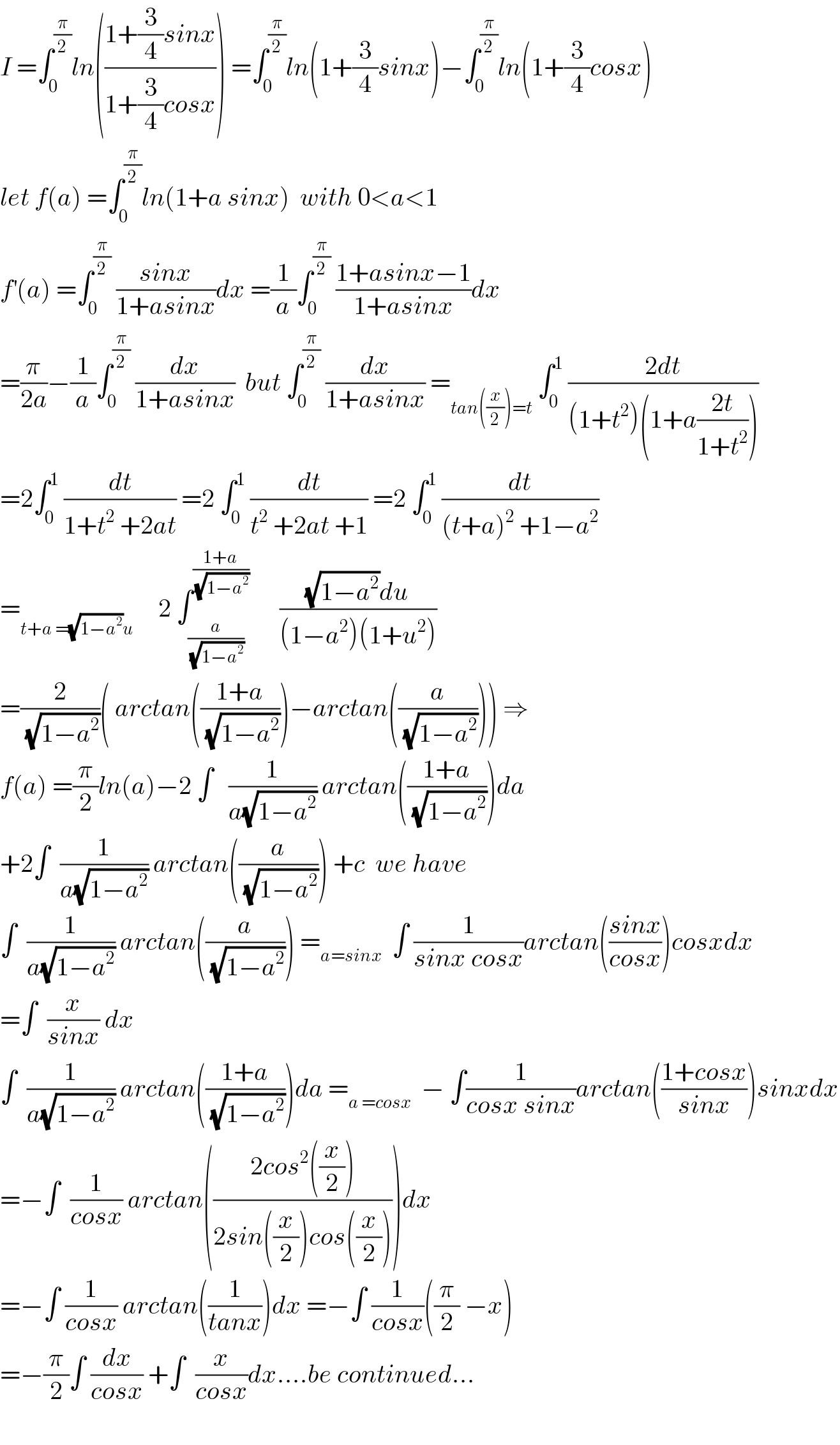Question Number 91493 by Zainal Arifin last updated on 01/May/20

$$\underset{\:\mathrm{0}} {\overset{\pi/\mathrm{2}} {\int}}\:\mathrm{log}\:\left(\frac{\mathrm{4}+\mathrm{3}\:\mathrm{sin}\:{x}}{\mathrm{4}+\mathrm{3}\:\mathrm{cos}\:{x}}\right){dx}\:= \\ $$
Commented by mathmax by abdo last updated on 01/May/20

$${I}\:=\int_{\mathrm{0}} ^{\frac{\pi}{\mathrm{2}}} {ln}\left(\frac{\mathrm{1}+\frac{\mathrm{3}}{\mathrm{4}}{sinx}}{\mathrm{1}+\frac{\mathrm{3}}{\mathrm{4}}{cosx}}\right)\:=\int_{\mathrm{0}} ^{\frac{\pi}{\mathrm{2}}} {ln}\left(\mathrm{1}+\frac{\mathrm{3}}{\mathrm{4}}{sinx}\right)−\int_{\mathrm{0}} ^{\frac{\pi}{\mathrm{2}}} {ln}\left(\mathrm{1}+\frac{\mathrm{3}}{\mathrm{4}}{cosx}\right) \\ $$$${let}\:{f}\left({a}\right)\:=\int_{\mathrm{0}} ^{\frac{\pi}{\mathrm{2}}} {ln}\left(\mathrm{1}+{a}\:{sinx}\right)\:\:{with}\:\mathrm{0}<{a}<\mathrm{1} \\ $$$${f}^{'} \left({a}\right)\:=\int_{\mathrm{0}} ^{\frac{\pi}{\mathrm{2}}} \:\frac{{sinx}}{\mathrm{1}+{asinx}}{dx}\:=\frac{\mathrm{1}}{{a}}\int_{\mathrm{0}} ^{\frac{\pi}{\mathrm{2}}} \:\frac{\mathrm{1}+{asinx}−\mathrm{1}}{\mathrm{1}+{asinx}}{dx} \\ $$$$=\frac{\pi}{\mathrm{2}{a}}−\frac{\mathrm{1}}{{a}}\int_{\mathrm{0}} ^{\frac{\pi}{\mathrm{2}}} \:\frac{{dx}}{\mathrm{1}+{asinx}}\:\:{but}\:\int_{\mathrm{0}} ^{\frac{\pi}{\mathrm{2}}} \:\frac{{dx}}{\mathrm{1}+{asinx}}\:=_{{tan}\left(\frac{{x}}{\mathrm{2}}\right)={t}} \:\int_{\mathrm{0}} ^{\mathrm{1}} \:\frac{\mathrm{2}{dt}}{\left(\mathrm{1}+{t}^{\mathrm{2}} \right)\left(\mathrm{1}+{a}\frac{\mathrm{2}{t}}{\mathrm{1}+{t}^{\mathrm{2}} }\right)} \\ $$$$=\mathrm{2}\int_{\mathrm{0}} ^{\mathrm{1}} \:\frac{{dt}}{\mathrm{1}+{t}^{\mathrm{2}} \:+\mathrm{2}{at}}\:=\mathrm{2}\:\int_{\mathrm{0}} ^{\mathrm{1}} \:\frac{{dt}}{{t}^{\mathrm{2}} \:+\mathrm{2}{at}\:+\mathrm{1}}\:=\mathrm{2}\:\int_{\mathrm{0}} ^{\mathrm{1}} \:\frac{{dt}}{\left({t}+{a}\right)^{\mathrm{2}} \:+\mathrm{1}−{a}^{\mathrm{2}} } \\ $$$$=_{{t}+{a}\:=\sqrt{\mathrm{1}−{a}^{\mathrm{2}} }{u}} \:\:\:\:\:\mathrm{2}\:\int_{\frac{{a}}{\:\sqrt{\mathrm{1}−{a}^{\mathrm{2}} }}} ^{\frac{\mathrm{1}+{a}}{\:\sqrt{\mathrm{1}−{a}^{\mathrm{2}} }}} \:\:\:\:\:\:\frac{\sqrt{\mathrm{1}−{a}^{\mathrm{2}} }{du}}{\left(\mathrm{1}−{a}^{\mathrm{2}} \right)\left(\mathrm{1}+{u}^{\mathrm{2}} \right)} \\ $$$$=\frac{\mathrm{2}}{\:\sqrt{\mathrm{1}−{a}^{\mathrm{2}} }}\left(\:{arctan}\left(\frac{\mathrm{1}+{a}}{\:\sqrt{\mathrm{1}−{a}^{\mathrm{2}} }}\right)−{arctan}\left(\frac{{a}}{\:\sqrt{\mathrm{1}−{a}^{\mathrm{2}} }}\right)\right)\:\Rightarrow \\ $$$${f}\left({a}\right)\:=\frac{\pi}{\mathrm{2}}{ln}\left({a}\right)−\mathrm{2}\:\int\:\:\:\frac{\mathrm{1}}{{a}\sqrt{\mathrm{1}−{a}^{\mathrm{2}} }}\:{arctan}\left(\frac{\mathrm{1}+{a}}{\:\sqrt{\mathrm{1}−{a}^{\mathrm{2}} }}\right){da} \\ $$$$+\mathrm{2}\int\:\:\frac{\mathrm{1}}{{a}\sqrt{\mathrm{1}−{a}^{\mathrm{2}} }}\:{arctan}\left(\frac{{a}}{\:\sqrt{\mathrm{1}−{a}^{\mathrm{2}} }}\right)\:+{c}\:\:{we}\:{have} \\ $$$$\int\:\:\frac{\mathrm{1}}{{a}\sqrt{\mathrm{1}−{a}^{\mathrm{2}} }}\:{arctan}\left(\frac{{a}}{\:\sqrt{\mathrm{1}−{a}^{\mathrm{2}} }}\right)\:=_{{a}={sinx}} \:\:\int\:\frac{\mathrm{1}}{{sinx}\:{cosx}}{arctan}\left(\frac{{sinx}}{{cosx}}\right){cosxdx} \\ $$$$=\int\:\:\frac{{x}}{{sinx}}\:{dx} \\ $$$$\int\:\:\frac{\mathrm{1}}{{a}\sqrt{\mathrm{1}−{a}^{\mathrm{2}} }}\:{arctan}\left(\frac{\mathrm{1}+{a}}{\:\sqrt{\mathrm{1}−{a}^{\mathrm{2}} }}\right){da}\:=_{{a}\:={cosx}} \:\:−\:\int\frac{\mathrm{1}}{{cosx}\:{sinx}}{arctan}\left(\frac{\mathrm{1}+{cosx}}{{sinx}}\right){sinxdx} \\ $$$$=−\int\:\:\frac{\mathrm{1}}{{cosx}}\:{arctan}\left(\frac{\mathrm{2}{cos}^{\mathrm{2}} \left(\frac{{x}}{\mathrm{2}}\right)}{\mathrm{2}{sin}\left(\frac{{x}}{\mathrm{2}}\right){cos}\left(\frac{{x}}{\mathrm{2}}\right)}\right){dx} \\ $$$$=−\int\:\frac{\mathrm{1}}{{cosx}}\:{arctan}\left(\frac{\mathrm{1}}{{tanx}}\right){dx}\:=−\int\:\frac{\mathrm{1}}{{cosx}}\left(\frac{\pi}{\mathrm{2}}\:−{x}\right) \\ $$$$=−\frac{\pi}{\mathrm{2}}\int\:\frac{{dx}}{{cosx}}\:+\int\:\:\frac{{x}}{{cosx}}{dx}….{be}\:{continued}… \\ $$$$ \\ $$
Answered by MJS last updated on 01/May/20

$$\mathrm{ln}\:\frac{\mathrm{4}+\mathrm{3sin}\:{x}}{\mathrm{4}+\mathrm{3cos}\:{x}}\:=−\mathrm{ln}\:\frac{\mathrm{4}+\mathrm{3sin}\:\left(\frac{\pi}{\mathrm{2}}−{x}\right)}{\mathrm{4}+\mathrm{3cos}\:\left(\frac{\pi}{\mathrm{2}}−{x}\right)}\:\Rightarrow \\ $$$$\Rightarrow\:\mathrm{answer}\:\mathrm{is}\:\mathrm{0} \\ $$
